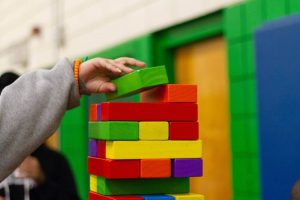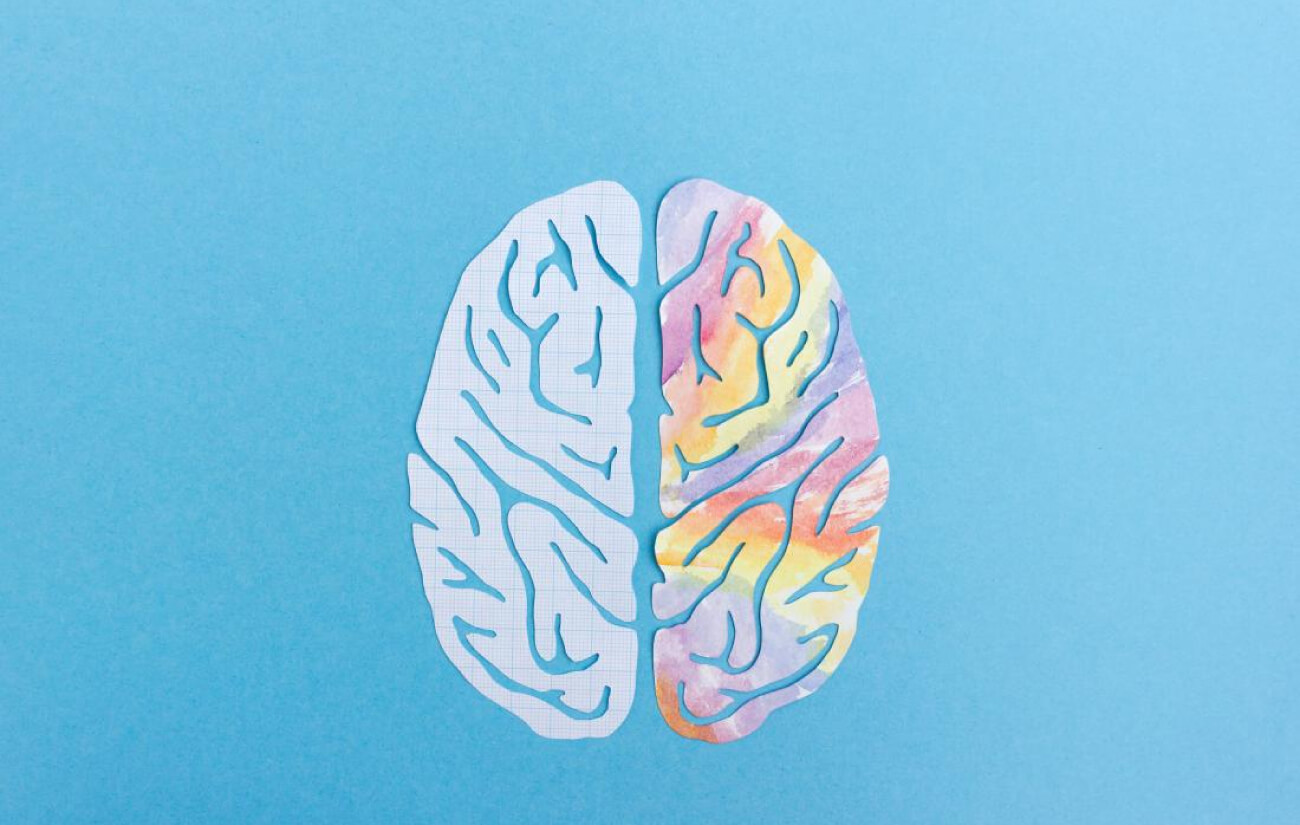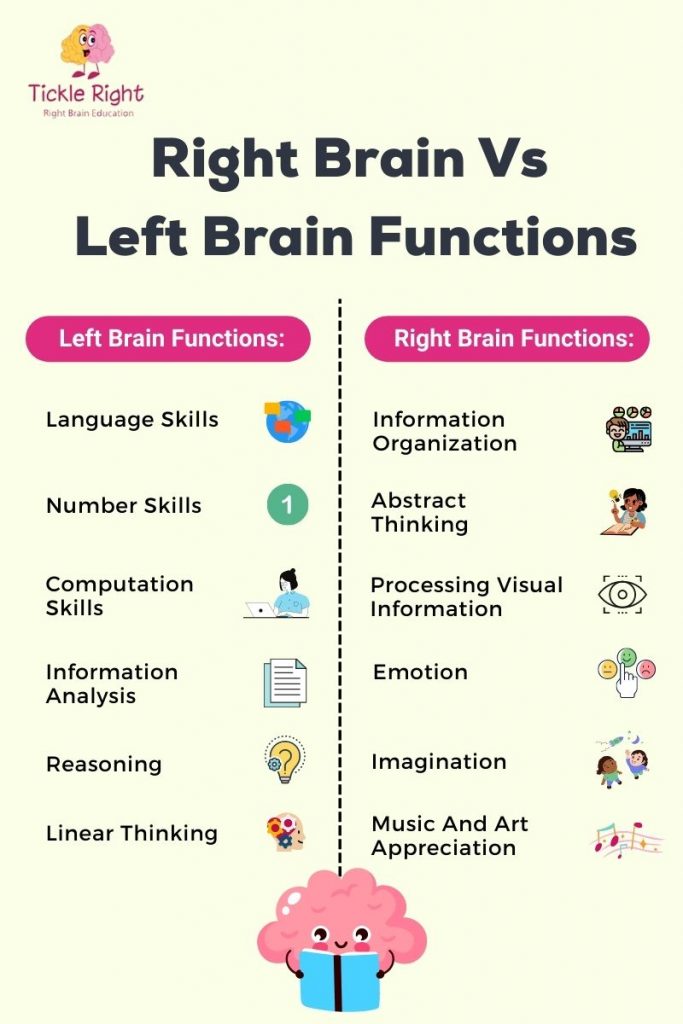Right Brain VS Left Brain Learner: Who Is Better?
Right Brain VS Left Brain Learner: Who Is Better?
Are you more of a ‘maths’ person or ‘arts’ person? This is a common question that we start getting asked in school. Sentences like “I am not creative,” “I hate maths,” “I am a right-brain dominant person,” or “I am a left-brained thinker” are commonly heard among adults and kids both. But how much of this right brain vs left brain thinking is really true?
Several facts have gotten oversimplified in the war between the analytical left-brained and the creative right-brained people. But let’s get one thing straight. No person or kid is walking around with one side of their brain hilariously bigger than the other. All of us have perfectly equal-sized brains, with each side busy chattering with the other.
The Indian schooling system focuses on memory and retention learning while stifling the kid’s creativity. At Tickle Right, we focus on activities that impart education with creativity. Our right brain education program prepares your child to be confident and empathetic with a lightening fast grasping speed.
Right Brain VS Left Brain Characteristics
The brain is divided into two parts– the left hemisphere and the right hemisphere. Each part of the brain focuses on a specific type of skill. The left hemisphere of the brain controls the right-hand side of the body. Left brain activities include speech, language, and recognizing words, letters, and numbers. The right hemisphere of the brain controls the left-hand side of the body. Right brain activities include creativity, organizing information, and interpreting social cues. It is also good at recognizing visual and spatial information.
The two hemispheres of the brain connect to each other by a bridge called the corpus callosum. They constantly coordinate with each other via this bridge. When we perform any activity, both sides of the brain process different aspects of the same information. It then coordinates with each other to give a response.
Right Brain Functions:
- Organization of information
- Abstract thinking, processing visual information
- Recognizing spatial relationships (e.g., map reading or shape recognition)
- Intuition, emotion, imagination
- Music and art appreciation
- Controls the left side of the body
Left Brain Functions:
- Speaking, reading, writing, listening
- Grammar
- Number skills & computation skills
- Information analysis
- Reasoning, logic, & linear thinking
- Controls the right side of the body
The Right Brain Dominant VS Left Brain Dominant: Which Is Better?
We humans really like to categorize ourselves. That’s why Buzzfeed quizzes are so popular. We divide ourselves and our kids into logical vs creative, like left brain vs right brain individuals. This is simply not correct. Any activity, be it as logical as maths or as creative like painting, requires both sides of the brain.
For example, in a conversation, the left brain focuses on picking out sounds that form words and understanding the syntax of a phrase. The right brain grasps the emotional features of the language, focusing on intonation and stress in the patterns of speech. Therefore, a conversation would need both sides of the brain. The left side to understand the language and the right side to pick up the social cues of the conversation.
We know what you are thinking, so why are some people more creative and others more logical? It comes down to training your brain to think a certain way. Regular schooling focuses on reading, writing, speaking, and analyzing information. Empathy, musical awareness, or any out-of-the-box thinking does not get due heed in general. The natural creative and curious nature of kids gets suppressed, and we seem to ‘lose’ our creativity by the time we become adults. But we never lose it. Just like any other skill, creativity becomes rusty from disuse.
At Tickle Right, we focus on right-side brain development activities. The best time to develop a child’s creative skills is when they are still at their most curious and creative. You must take leverage of their rapidly expanding brains to train them in visualization skills. This enhances their photographic memory and instills confidence, patience, self-expression, and speaking skills in each child. Right brain training activities such as processing and recognizing visual data at lightning speed. It enables their brains to develop a faster reaction time.
Strengthening The Left Brain And Right Brain Connections
The brain consists of billions of neural pathways. You can imagine these pathways sort of as hiking trails. With enough use, a hiking trail would become well-worn and easy to travel by. On the other hand, a less-traveled trail would become overgrown and gradually become lost. The brain is somewhat similar. Learning and new experiences can form and strengthen new pathways. Infrequently used pathways get ‘pruned.’
The good news is that the brain’s enormous capacity to learn can is advantageous to us. One can take up several activities to enhance the connections in the brain.
- Making Art: Experimenting with different arts will help create new brain pathways. It enhances brain connections and boosts brain performance overall.
- Exercise: Physical activity for at least 30 minutes improves memory and motor skill coordination. It also improves memory, attention span, and the overall efficiency of the brain.
- Learning A Musical Instrument: There is mental and physical syncing required to learn a musical instrument. It is a fantastic workout for the brain. It boosts bilateral brain connectivity.
- Learning A Foreign Language: It’s a complex brain activity. It requires the brain to shift from thinking to speaking in another language. It also requires memory expansion which stimulates the brain.
- Reading Complex Things: Reading things outside your comfort zone increases brain activity. It speeds up your mental processing and boosts connectivity in the brain.
- Hobbies Needing Mental & Physical Coordination: Any hobby that involves new thinking and physical coordination. Any sort of new activity will constantly stimulate both sides of the brain, especially if they involve cognition, memory, and physical coordination. For e.g., Quilting, knitting, dancing, sketching, etc.
Tips To Mind When Your Child Learns With Right-Brain Activities
While you boost your child’s learning with right-brain activities, here are some tips to keep in mind:
1. Avoid Labels – Creative Or Uncreative
Kids take any label or name very seriously. It is not conscious on their part. If you label them as ‘better at math and science’ and ‘uncreative,’ they will actively try not to pursue creative subjects at school. They may shun any creative hobbies. Instead, let them explore different subjects and interests with equal encouragement. Any judgment or label might kill their creativity.
2. Allow Freedom & Independence
Kids, left to their own devices, come up with the most imaginative ideas. Letting children explore their interests encourages their creativity. Instead of over-managing the kids, let them know it’s okay to draw outside the lines. You can even encourage them to come up with their own plans and games for a day to nurture their creativity.
3. Encourage The Freedom To Explore
Often we persuade our kids to pursue sports or hobbies that we ourselves enjoy or want them to be good at. Instead, allow them the freedom to explore a bunch of activities and choose their areas of interest. Pay attention to their areas of passion and put those activities at their fingertips.
4. Reduce Media Consumption
Do you know getting bored is good for your brain? Research shows that periods of boredom are followed by boosts in creativity. During the idle time, your brain processes stuff from before and forms new connections between ideas. Consuming too much TV, YouTube, and other media gets in the way of creative thinking in kids and adults alike.
5. Don’t Reward Their Creativity
I know, so contradictory, right? You must motivate your kids to be creative, but you shouldn’t reward them? Well, the key to long-term creative success is when it is intrinsically motivated. Incentivising creativity could affect the free-flowing nature of creativity and make it one more thing that needs to be successful. Instead, emphasize their creative thought process more than the actual result.
6. No Idea Is Bad
Kids’ brains are full of creative ideas. Dismissing or ridiculing those would stop their creativity. While the ideas might be bad but there was effort and thought process behind it. Help them out with the good bits and ask them questions to make them understand what more they need to consider to implement the idea. The environment should be such that they shouldn’t be afraid to make mistakes.
FAQ

1. Who becomes successful right brain or the left brain dominant?
Every person, whether creative like a musician or analytical like a mathematician, uses both parts of the brain equally to perform any activity. Creative thinking, or logical thinking as traditionally defined, is a skill that people can be trained into.
2. How do you know if you are left or right brain?
The left brain and right brain ideas have a basis in the brain lateralization theory. While there are specific regions of the brain for particular functions, the dominance of one hemisphere of the brain over the other is a myth.
3. Can a person be both left and right-brained?
The left brain has more analytical functions, and the right brain has more creativity-oriented functions. Both sides of the brain talk to each other continuously and act together to give a response. Everyone uses both sides of the brain continually in their daily lives.
4. Are left-brained thinkers smarter?
The left brain deals with the analytical, computational, reasoning, and linear thinking skills of our brain. The right brain deals with creativity, abstract thinking, processing visual information, and empathy. Both sides of the brain work in sync continuously for all people. Therefore, no one is ‘smarter’ than the other.
Takeaway
Your brain is an immensely malleable organ. It is capable of more than you think. While there are regions that specialize in particular functions, all parts of the brain always work together. While there are no left-brained and right-brained people, at Tickle Right, we aim to teach the kids in the most creative way possible.


